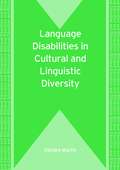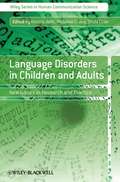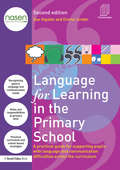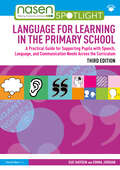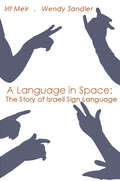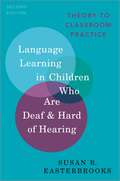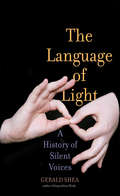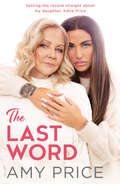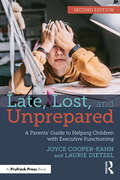- Table View
- List View
Language Development for Science: Circle Time Sessions to Improve Language Skills
by Marion Nash Jackie LoweThis book is the first of its kind to help practitioners specifically develop children's language skills in Science. The book incudes: guidelines to help teachers set up, run and assess circle-time sessions ideas for promoting children's thinking skills and emotional literacy video CD containing explanation and demonstration of the programme and its implementation, with comments from staff who have used it.
Language Disabilities in Cultural and Linguistic Diversity (Bilingual Education & Bilingualism 71) (PDF)
by Deirdre MartinLanguage Disabilities in Cultural and Linguistic Diversity takes a critical perspective on traditional bio-cognitive-social approaches to language disabilities – specific language impairment, communication difficulties, dyslexia and deafness. A socio-cultural approach orientates a reinterpretation of research, educational practices and policies in assessment, teaching and intervention. A Vygotskian framework affords repositioning of assessment, learning and development for language disabilities as they are influenced and shaped by experiences of multilingualism, culture, ethnicity and race. The author, rather than present definitive answers, aims to offer new analyses and extend current understanding of linguistic phenomena fraught by dilemmas of disentangling diversity and disability. The volume serves as a source of reflection and inquiry for students, professionals and policy makers in education and health who are interested in disability and language disabilities in multilingual and multicultural contexts.
Language Disorders From a Developmental Perspective: Essays in Honor of Robin S. Chapman (New Directions in Communication Disorders Research)
by Rhea PaulThe last 25 years have witnessed an explosion of research at the intersection of typical language development and child language disorders. A pioneer in bringing these fields of study together is Robin S. Chapman, Emerita, University of Wisconsin. This contributed volume honors her with chapters written by former students and colleagues, who track in their own research the theme of psycholinguistic contributions to our understanding of the nature and remediation of child language disorders. In this volume, such renowned researchers in child language development as Dorothy Bishop, Judith Johnston, and Ray Kent, among others, discuss their research in certain populations in the context of the significance of, limits of, and alternatives to Robin Chapman’s developmental interactionist perspective. Studies of disordered language in Down’s Syndrome and Specific Language Impairment, in particular, attribute much progress in our understanding of the pragmatic and comprehension skills in these populations to the developmental perspective. Language Disorders From a Developmental Perspective opens with a reprint of Robin Chapman’s seminal 2001 article from The Journal of Child Psychiatry and Psychology. It concludes with a new chapter from Dr. Chapman summarizing what we know and what we don’t know about language disorders within the developmental framework, and pointing to future areas of research and intervention. Clinicians as well as scholars will benefit from this book, as will students in programs of developmental psycholinguistics, child language disorders, and learning disabilities.
Language Disorders From a Developmental Perspective: Essays in Honor of Robin S. Chapman (New Directions in Communication Disorders Research)
by Rhea PaulThe last 25 years have witnessed an explosion of research at the intersection of typical language development and child language disorders. A pioneer in bringing these fields of study together is Robin S. Chapman, Emerita, University of Wisconsin. This contributed volume honors her with chapters written by former students and colleagues, who track in their own research the theme of psycholinguistic contributions to our understanding of the nature and remediation of child language disorders. In this volume, such renowned researchers in child language development as Dorothy Bishop, Judith Johnston, and Ray Kent, among others, discuss their research in certain populations in the context of the significance of, limits of, and alternatives to Robin Chapman’s developmental interactionist perspective. Studies of disordered language in Down’s Syndrome and Specific Language Impairment, in particular, attribute much progress in our understanding of the pragmatic and comprehension skills in these populations to the developmental perspective. Language Disorders From a Developmental Perspective opens with a reprint of Robin Chapman’s seminal 2001 article from The Journal of Child Psychiatry and Psychology. It concludes with a new chapter from Dr. Chapman summarizing what we know and what we don’t know about language disorders within the developmental framework, and pointing to future areas of research and intervention. Clinicians as well as scholars will benefit from this book, as will students in programs of developmental psycholinguistics, child language disorders, and learning disabilities.
Language Disorders in Children and Adults: New Issues in Research and Practice
by Victoria Joffe Madeline Cruice Shula ChiatThis book contains contributions from eminent clinicians and researchers in the field of language impairment, and crosses the bridge between children and adults. It reflects the developments that have taken place in Speech and Language Therapy over the past 10 years and focuses on issues in SLT that have recently come into ascendancy. These include: personal and social consequences of language disability, and how to measure these; the evidence base for speech and language therapy interventions; language processing and the interplay between language and cognition; and the degree to which impairments in one affect the other. There is a growing concern about the needs of adolescents who have language difficulties - a group who, by their age, development and experience straddle the child/adult divide. It extends the themes by looking at future implications and sets out the challenges ahead for the speech and language therapy profession.
Language for Learning in the Primary School: A practical guide for supporting pupils with language and communication difficulties across the curriculum (nasen spotlight)
by Sue Hayden Emma JordanLanguage for Learning in the Primary School is the long awaited second edition of Language for Learning, first published in 2004 and winner of the NASEN/TES Book Award for Teaching and Learning in 2005. This handbook has become an indispensable resource, packed full of practical suggestions on how to support 5-11 year old children with speech, language and communication difficulties. Colour coded throughout for easy referencing, this unique book supports inclusive practice by helping teachers to: Identify children with speech, language and communication needs (SLCN) Understand speech, language and communication skills Consider roles and responsibilities at primary school Plan a differentiated and adapted curriculum Consider the language demands across subjects Adopt a whole school approach Make use of a wide range of positive strategies Empower children to access the curriculum Language for Learning in the Primary School comes complete with a wealth of photocopiable resources, giving teachers and teaching assistants the confidence to help children with SLCN more effectively in mainstream settings. It will also be an extremely useful resource for speech and language therapists, specialist teachers and educational psychologists.
Language for Learning in the Primary School: A Practical Guide for Supporting Pupils with Speech, Language and Communication Needs Across the Curriculum (nasen spotlight)
by Sue Hayden Emma JordanThe third edition of Language for Learning in the Primary School is an indispensable resource, packed full of practical suggestions on how to support 5-11-year-old children with speech, language, and communication needs. Colour coded throughout for easy referencing, this unique book supports inclusive practice by helping teachers to: Identify children with speech, language, and communication needs (SLCN) Understand speech, language, and communication skills Consider roles and responsibilities at primary school Plan a differentiated and adapted curriculum Consider the language demands across subjects Adopt a whole-school approach Make use of a wide range of positive strategies to support children in the classroom Empower children to access the curriculum Fully revised and updated, Language for Learning in the Primary School, 3rd edition, comes complete with a wealth of photocopiable and downalodable resources, giving teachers and teaching assistants the confidence to help children with SLCN more effectively in mainstream settings. It will also be an extremely useful resource for speech and language therapists, specialist teachers, and educational psychologists.
Language for Learning in the Primary School: A Practical Guide for Supporting Pupils with Speech, Language and Communication Needs Across the Curriculum (nasen spotlight)
by Sue Hayden Emma JordanThe third edition of Language for Learning in the Primary School is an indispensable resource, packed full of practical suggestions on how to support 5-11-year-old children with speech, language, and communication needs. Colour coded throughout for easy referencing, this unique book supports inclusive practice by helping teachers to: Identify children with speech, language, and communication needs (SLCN) Understand speech, language, and communication skills Consider roles and responsibilities at primary school Plan a differentiated and adapted curriculum Consider the language demands across subjects Adopt a whole-school approach Make use of a wide range of positive strategies to support children in the classroom Empower children to access the curriculum Fully revised and updated, Language for Learning in the Primary School, 3rd edition, comes complete with a wealth of photocopiable and downalodable resources, giving teachers and teaching assistants the confidence to help children with SLCN more effectively in mainstream settings. It will also be an extremely useful resource for speech and language therapists, specialist teachers, and educational psychologists.
Language for Learning in the Primary School: A practical guide for supporting pupils with language and communication difficulties across the curriculum (nasen spotlight)
by Sue Hayden Emma JordanLanguage for Learning in the Primary School is the long awaited second edition of Language for Learning, first published in 2004 and winner of the NASEN/TES Book Award for Teaching and Learning in 2005. This handbook has become an indispensable resource, packed full of practical suggestions on how to support 5-11 year old children with speech, language and communication difficulties. Colour coded throughout for easy referencing, this unique book supports inclusive practice by helping teachers to: Identify children with speech, language and communication needs (SLCN) Understand speech, language and communication skills Consider roles and responsibilities at primary school Plan a differentiated and adapted curriculum Consider the language demands across subjects Adopt a whole school approach Make use of a wide range of positive strategies Empower children to access the curriculum Language for Learning in the Primary School comes complete with a wealth of photocopiable resources, giving teachers and teaching assistants the confidence to help children with SLCN more effectively in mainstream settings. It will also be an extremely useful resource for speech and language therapists, specialist teachers and educational psychologists.
Language for Learning in the Secondary School: A Practical Guide for Supporting Students with Speech, Language and Communication Needs (nasen spotlight)
by Sue Hayden Emma JordanLanguage for Learning in the Secondary School employs the same easy-to-use format as the best-selling Primary version of this book but has been adapted to meet the specific needs of secondary school teachers. This indispensable resource is packed full of practical suggestions on how to support students with speech, language and communication difficulties. Colour coded throughout for easy referencing, this unique book supports inclusive practice by helping you to: Identify students with speech, language and communication needs Understand how language is processed Consider roles and responsibilities at secondary level Plan a differentiated curriculum Consider the language demands across the subjects Adopt a whole school approach Make use of a wide range of positive strategies Empower students to access the curriculum. Language for Learning in the Secondary School comes complete with a wealth of photocopiable resources and activities, giving teachers and teaching assistants the confidence to help students with speech, language and communication needs more effectively in mainstream settings. It will also be an extremely useful resource for specialist teachers, speech and language therapists and educational psychologists.
Language for Learning in the Secondary School: A Practical Guide for Supporting Students with Speech, Language and Communication Needs (nasen spotlight)
by Sue Hayden Emma JordanLanguage for Learning in the Secondary School employs the same easy-to-use format as the best-selling Primary version of this book but has been adapted to meet the specific needs of secondary school teachers. This indispensable resource is packed full of practical suggestions on how to support students with speech, language and communication difficulties. Colour coded throughout for easy referencing, this unique book supports inclusive practice by helping you to: Identify students with speech, language and communication needs Understand how language is processed Consider roles and responsibilities at secondary level Plan a differentiated curriculum Consider the language demands across the subjects Adopt a whole school approach Make use of a wide range of positive strategies Empower students to access the curriculum. Language for Learning in the Secondary School comes complete with a wealth of photocopiable resources and activities, giving teachers and teaching assistants the confidence to help students with speech, language and communication needs more effectively in mainstream settings. It will also be an extremely useful resource for specialist teachers, speech and language therapists and educational psychologists.
Language for Living: Communication Activities for Young Adults with Learning Difficulties
by Catherine DelamainThis title features communication activities for young adults with learning difficulties. This unique collection of 180 enjoyable group activities aims to foster both the skills underlying communication, such as body language and awareness of others, and aspects of spoken language itself. The activities fall broadly within the Entry Levels 1-3 of the Skills for Life Core Curriculum, but can be used as a completely independent programme. The book addresses the needs of students with very varied skill levels, and includes some activities which can be used with non-verbal students. "Language for Living" has the following advantages: no formal assessment necessary; equipment not required or kept to a minimum; activities can be freely adapted to suit students' lifestyles and experience; activities are simple to organise, and easy to fit in to the daily programme of college, day or residential settings; photocopiable resource section; and CD-ROM for optional record-keeping and printable resources.
Language for Living: Communication Activities for Young Adults with Learning Difficulties
by Catherine DelamainThis title features communication activities for young adults with learning difficulties. This unique collection of 180 enjoyable group activities aims to foster both the skills underlying communication, such as body language and awareness of others, and aspects of spoken language itself. The activities fall broadly within the Entry Levels 1-3 of the Skills for Life Core Curriculum, but can be used as a completely independent programme. The book addresses the needs of students with very varied skill levels, and includes some activities which can be used with non-verbal students. "Language for Living" has the following advantages: no formal assessment necessary; equipment not required or kept to a minimum; activities can be freely adapted to suit students' lifestyles and experience; activities are simple to organise, and easy to fit in to the daily programme of college, day or residential settings; photocopiable resource section; and CD-ROM for optional record-keeping and printable resources.
Language for Thinking: A structured approach for young children: The Colour Edition
by Stephen Parsons Anna BranaganThis photocopiable resource provides a clear structure to assist teachers, SENCOs, learning support assistants and speech language therapists in developing children's language from the concrete to the abstract. It is based on fifty picture and verbal scenarios that can be used flexibly with a wide range of ages and abilities. Quick, practical and easy to use in the classroom, this programme can be used with individual children, in small groups or can form the basis of a literacy lesson or speech language therapy session. Features: question sheets are carefully structured to promote children's development of inference, verbal reasoning and thinking skills; the three parallel assessments of spoken and written language can be used to assess each child's starting level and then to monitor progress; score forms and worksheets for each lesson are included. The book is particularly useful for children who are recognised as having delayed language skills, specific language impairment, Autism Spectrum Disorder (including Asperger's Syndrome), pragmatic language impairment or moderate learning difficulties. The 2nd Edition is now in full colour throughout and has been updated with a simplified introduction. All illustrations and worksheets will now be available online. Features: full colour throughout; new and revised illustrations; simplified introduction; online resources; illustrations and worksheets.
Language for Thinking: A structured approach for young children: The Colour Edition
by Stephen Parsons Anna BranaganThis photocopiable resource provides a clear structure to assist teachers, SENCOs, learning support assistants and speech language therapists in developing children's language from the concrete to the abstract. It is based on fifty picture and verbal scenarios that can be used flexibly with a wide range of ages and abilities. Quick, practical and easy to use in the classroom, this programme can be used with individual children, in small groups or can form the basis of a literacy lesson or speech language therapy session. Features: question sheets are carefully structured to promote children's development of inference, verbal reasoning and thinking skills; the three parallel assessments of spoken and written language can be used to assess each child's starting level and then to monitor progress; score forms and worksheets for each lesson are included. The book is particularly useful for children who are recognised as having delayed language skills, specific language impairment, Autism Spectrum Disorder (including Asperger's Syndrome), pragmatic language impairment or moderate learning difficulties. The 2nd Edition is now in full colour throughout and has been updated with a simplified introduction. All illustrations and worksheets will now be available online. Features: full colour throughout; new and revised illustrations; simplified introduction; online resources; illustrations and worksheets.
A Language in Space: The Story of Israeli Sign Language
by Irit Meir Wendy SandlerThis English version of A Language in Space: The Story of Israeli Sign Language, which received the Bahat Award for most outstanding book for a general audience in its Hebrew edition, is an introduction to sign language using Israeli Sign Language (ISL) as a model. Authors Irit Meir and Wendy Sandler offer a glimpse into a number of fascinatin
A Language in Space: The Story of Israeli Sign Language
by Irit Meir Wendy SandlerThis English version of A Language in Space: The Story of Israeli Sign Language, which received the Bahat Award for most outstanding book for a general audience in its Hebrew edition, is an introduction to sign language using Israeli Sign Language (ISL) as a model. Authors Irit Meir and Wendy Sandler offer a glimpse into a number of fascinatin
Language Learning in Children Who Are Deaf and Hard of Hearing: Theory to Classroom Practice (Professional Perspectives on Deafness: Evidence and Applications)
by Susan R. EasterbrooksThis volume is the long-awaited revision of the only textbook on primary language instruction written with classroom teachers of deaf and hard-of-hearing children (TODs) in mind. It builds on the work of the previous edition, describing the experiences of four real TODs and demonstrates practical application of the concepts discussed. Up-to-date chapters on theory of language learning, assessment, and evidence-based practice supplement specific examples of real cases in the field. Avoiding promotion of one teaching philosophy over another, this volume demonstrates the commonalities across classroom language instruction approaches for DHH children and helps guide teachers to enhance learning outcomes.
Language Learning in Children Who Are Deaf and Hard of Hearing: Theory to Classroom Practice (Professional Perspectives on Deafness: Evidence and Applications)
by Susan R. EasterbrooksThis volume is the long-awaited revision of the only textbook on primary language instruction written with classroom teachers of deaf and hard-of-hearing children (TODs) in mind. It builds on the work of the previous edition, describing the experiences of four real TODs and demonstrates practical application of the concepts discussed. Up-to-date chapters on theory of language learning, assessment, and evidence-based practice supplement specific examples of real cases in the field. Avoiding promotion of one teaching philosophy over another, this volume demonstrates the commonalities across classroom language instruction approaches for DHH children and helps guide teachers to enhance learning outcomes.
The Language of Light: A History of Silent Voices
by Gerald SheaA comprehensive history of deafness, signed languages, and the unresolved struggles of the Deaf to be taught in their unspoken tongue Partially deaf due to a childhood illness, Gerald Shea is no stranger to the search for communicative grace and clarity. In this eloquent and thoroughly researched book, he uncovers the centuries-long struggle of the Deaf to be taught in sign language—the only language that renders them complete, fully communicative human beings. Shea explores the history of the deeply biased attitudes toward the Deaf in Europe and America, which illogically forced them to be taught in a language they could neither hear nor speak. As even A.G. Bell, a fervent oralist, admitted, sign language is "the quickest method of reaching the mind of a deaf child." Shea’s research exposes a persistent but misguided determination among hearing educators to teach the Deaf orally, making the very faculty they lacked the principal instrument of their instruction. To forbid their education in sign language—the “language of light”—is to deny the Deaf their human rights, he concludes.
Large-scale Testing of Students With Disabilities: A Special Issue of exceptionality
by Gerald TindalLarge Scale Testing of Students With Disabilities addresses three issues: accommodations, modifications, and reporting of outcomes. The purpose is not to present an exhaustive summary of the research in these areas but to focus attention on how the issues are considered and empirically validated. The research summarized in this issue should serve as a model for state departments to consider in adoption of policy, either as findings upon which to inform policy or as a method to adopt in generating findings themselves. The studies reflect critical methodologies that are either experimental in design or use extant data sets as well as present a theoretical framework in how to interpret empirical results.
Large-scale Testing of Students With Disabilities: A Special Issue of exceptionality
by Gerald TindalLarge Scale Testing of Students With Disabilities addresses three issues: accommodations, modifications, and reporting of outcomes. The purpose is not to present an exhaustive summary of the research in these areas but to focus attention on how the issues are considered and empirically validated. The research summarized in this issue should serve as a model for state departments to consider in adoption of policy, either as findings upon which to inform policy or as a method to adopt in generating findings themselves. The studies reflect critical methodologies that are either experimental in design or use extant data sets as well as present a theoretical framework in how to interpret empirical results.
The Last Word
by Amy PriceRaw and unflinching This is a mother’s account of her daughter’s life And of Katie Price and her turbulent rise to fame
Late, Lost, and Unprepared: A Parents’ Guide to Helping Children with Executive Functioning
by Joyce Cooper-Kahn Laurie DietzelDoes your child have difficulty meeting deadlines, staying organized, or keeping track of important information? Do they tend to forget details? Are they prone to emotional meltdowns? This book will become your go-to, all-inclusive guide to helping children manage issues with these executive functions, a set of related yet distinct mental skills that allow us to stay on target as we work toward our goals.Packed with encouragement, strategies, overviews, case studies, tips, and more, this newly revised edition offers science-based information explained in accessible, everyday language. You will find down to earth examples and a flexible framework that allows you to think on your feet and adapt the strategies to any child or situation.In addition to providing approaches for helping your child to manage demands in the short run, this book offers strategies for building independent skills for long-term self-management. Covering what you need to know, as well as what you can do, Late, Lost, and Unprepared gives parents the support they need to help their child become productive and independent – today and in the future.
Late, Lost, and Unprepared: A Parents’ Guide to Helping Children with Executive Functioning
by Joyce Cooper-Kahn Laurie DietzelDoes your child have difficulty meeting deadlines, staying organized, or keeping track of important information? Do they tend to forget details? Are they prone to emotional meltdowns? This book will become your go-to, all-inclusive guide to helping children manage issues with these executive functions, a set of related yet distinct mental skills that allow us to stay on target as we work toward our goals.Packed with encouragement, strategies, overviews, case studies, tips, and more, this newly revised edition offers science-based information explained in accessible, everyday language. You will find down to earth examples and a flexible framework that allows you to think on your feet and adapt the strategies to any child or situation.In addition to providing approaches for helping your child to manage demands in the short run, this book offers strategies for building independent skills for long-term self-management. Covering what you need to know, as well as what you can do, Late, Lost, and Unprepared gives parents the support they need to help their child become productive and independent – today and in the future.

